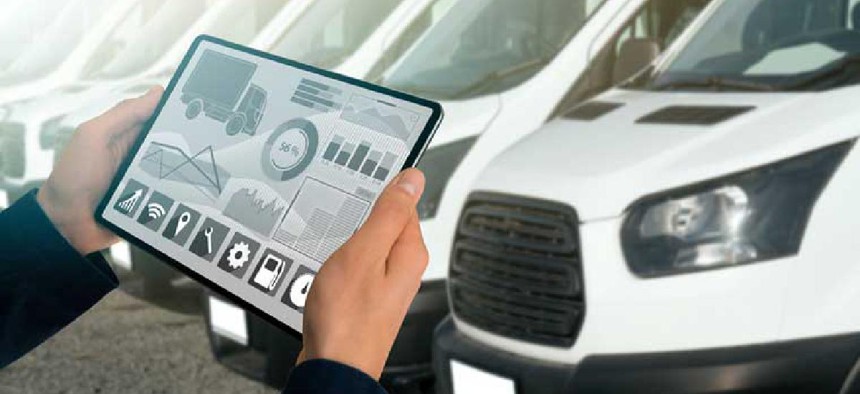Telematics streamlines data collection, analysis for managing state vehicles


Connecting state and local government leaders
Virginia Office of Emergency Medical Services has outfitted field inspectors’ vehicles with telematics sensors that collect data and transmit it to the cloud for analysis.
The Virginia Office of Emergency Medical Services (OEMS) has eliminated paper-based tracking and logging of field inspectors’ vehicles by outfitting them with telematics sensors that collect data and transmit it to the cloud for analysis.
Until about a year ago, OEMS Fleet and Logistics Administrator Frank Cheatham collected various paper reports to monitor the inspectors who traverse the state’s 42,774 square miles to check the training, certification and credentials of state emergency medical personnel.
For instance, “every time they’d purchase fuel, they would have to make a note in the log. Then they would be required to send me the receipt so that I could put that in a spreadsheet,” Cheatham said. ”When we got the bill twice a month, the fiscal people could justify the bill against the purchases.”
Now, a tracking device is installed in each vehicle or asset such as a trailer. The device determines the vehicle location with GPS and can collects data on engine fault codes. The systems also monitors driver behavior using an integrated accelerometer to detect changes in speed, acceleration and braking.
All of this data is transmitted to the CalAmp cloud via a cellular network. Location updates are typically sent every 30 seconds, for every left or right turn, or when it notes that a vehicle is speeding. Vehicle and asset information is displayed in CalAmp iOn fleet management software on an Esri map, and customer data, such as utility shut-off valves, can be added to the map to provide additional information for the fleet manager.
The system allow inspectors to send in photos of fuel receipts from their cellphones, reducing the paperwork burden, Cheatham said. “The monthly log was eliminated [and] I … could go in the system and look at any particular day if someone raised the question, What was this vehicle doing? Where was this fuel purchase made?” he said. “I could look at [the driver’s] track for the day and come up with it.”
Similarly, inspectors used to have to track the date, time and tolls they paid when they passed through a tollbooth, a cumbersome and potentially dangerous task, but one required for reconciling toll expenses on E-ZPass.
OEMS solved that issue through geofencing. Using the iOn software, Cheatham can and configure a geofence by clicking on a point on a map and dragging a circle, rectangle or polygon around an area. Then, the system will generate reports and display on the dashboard information about which vehicles entered and exited the geofenced toll boundaries.
“With the geofencing, we are able to quickly go back if we’re asked and check and make sure that the charge was appropriate,” Cheatham said.
He’s also used the system several times when field reps have called in about a check-engine light. Using the software, Cheatham can pull the fault codes and share them with a mechanic to determine whether the vehicle could be sidelined immediately, brought to a local mechanic or towed to headquarters.
CalAmp provides the entire solution, including the hardware, software and hosting. When a tracking device is installed in a vehicle, it pairs with GPS satellites; captures vehicle data such as braking frequency and force, speed, and engine health; and then sends that information to the CalAmp cloud. There, the data is analyzed, and the dashboards, reports and alerts are generated. Because it is cloud-based, the system is accessible on desktop computers, laptops and smartphones.
The data is used to track driver behavior, vehicle maintenance and general health of the system – what tracking areas are working well.
“The system is always pulling and capturing data,” said Bill Westerman, vice president of production management at CalAmp. “There’s nothing that has to happen to make the system work. Once it’s plugged in and set up, it’s always capturing data, sending updates. Location updates are sent typically every 30 seconds. Any kind of activity like a speeding event would be sent in real time as it happens, and all that information is being collected and managed in our system,” he said.
“The whole idea is to provide a system to manage by exception so you don’t necessarily have to have somebody sitting in front a computer all the time,” he added. “You can get alerts, you can get reports that are sorted worst to first. The reports can be scheduled. They may be sent to someone’s email.”
One challenge that has come up is cell coverage, Cheatham said. At the time of our interview on Sept. 21, he was able to see data on a vehicle in rural southwest Virginia, but information on one in downtown Richmond was stalled.
To help with the issue, OEMS will add signal boosters to the eight to 10 solar trailers outfitted for cellular connectivity that it’s preparing to deploy statewide.
Although Cheatham said he has not drilled into how much time the technology is saving him or field reps, “the enthusiasm of the field reps was enough to tell us it was working.”
NEXT STORY: 5 ways to unlock value in government data




